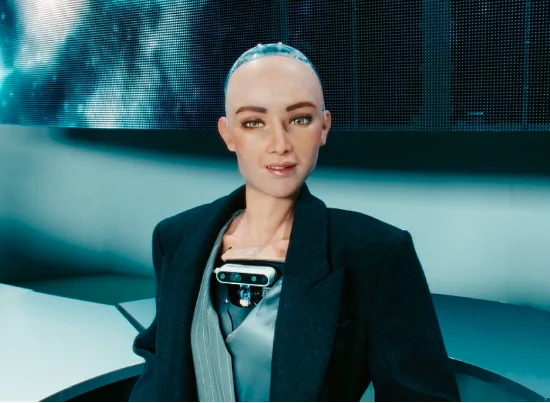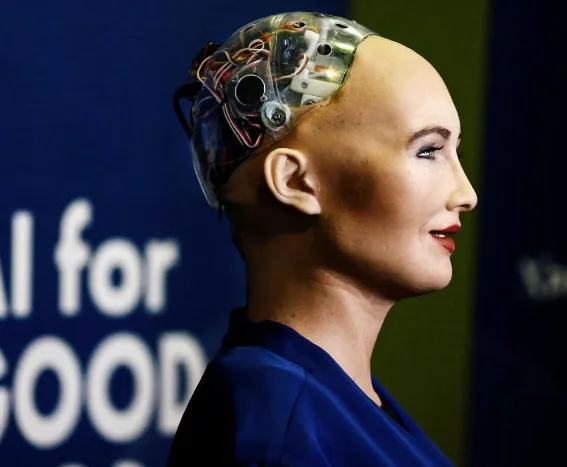Update: This article was last updated on 16th May 2024 to reflect the accuracy and up-to-date information on the page.
Interesting facts about the humanoid robot Sophia
- She is 7 years old
- She has cameras for eyes and microphones for ears.
- She has artificial skin to make her look more like a human being.
- She is programmed to learn from her interactions and experiences,
- She doesn’t understand sarcasm
- Her appearance is inspired by Audrey Hepburn and David Hanson’s late wife, Amanda.

Did you know that there are over 3 million robots in the world? They come in various shapes and sizes, each designed to perform specific tasks. But the ones that capture our imagination are humanoid robots. These robots are created to mimic human behavior, movements, and even appearance, to interact with us more naturally.
At just seven years old, Sophia has raised important questions about the future of robotics and artificial intelligence (AI).
In today’s technology-driven world, it’s crucial for kids to understand the capabilities and limitations of robots like Sophia and to think critically about their impact on society.
One of the most fascinating and talked about humanoid robots is Sophia. Developed by Hanson Robotics, a Hong Kong-based company, Sophia has gained worldwide attention for her eerily lifelike appearance and remarkable communication skills.
Sophia the robot, made by Hanson Robotics, shows how science, engineering, and art can come together in AI and robots. She’s famous worldwide for captivating people and pushing research limits.
Her unique personality and research contributions make people wonder if AI can become sentient. With AI advancing quickly, Sophia shows us endless possibilities in robotics and artificial intelligence.

Image Source: Slate.com
In this blog, we’ll share what kids should know about Sophia the Robot. We’ll explore her amazing capabilities, limitations, and the potential benefits and challenges of AI and robotics. So, buckle up and get ready to discover the exciting world of Sophia and the future of robotics!
1. Background
Apart from its origin in Hong Kong, Sophia, the Robot debuted on February 14, 2016. David Hanson is her designer. Designed to excel in science, education, and entertainment applications, Sophia the AI Robot aims to mimic human behavior and interaction through facial expressions, hand gestures, and the ability to converse. Unlike other robots, she’s programmed to learn and grow from her experiences.
2. Appearance
This marvel of engineering resembles a human, with camera “eyes” and microphone “ears” that grant her human-like sight and hearing. To enhance her lifelike qualities, Sophia the robot is equipped with specially designed artificial skin. Interestingly, her creator drew inspiration from both the legendary Audrey Hepburn and his late wife, Amanda Hanson.
3. Communication
One of the most impressive features of Sophia the AI Robot is her ability to communicate with people using natural language. She uses machine learning algorithms to analyze and understand the meaning of human speech, which allows her to carry on conversations with people. Sophia the Robot has been programmed to respond to questions, make jokes, and tell stories. However, she is unable to understand sarcasm.
4. Limitations
While Sophia the Robot can perform a wide range of tasks vast array of tasks, she still relies on human programmers to create and update her software. Additionally, Sophia the AI Robot lacks full autonomy and requires human supervision to operate.
5. Public Appearances
Sophia has made many appearances on TV and in various media outlets, where she has been interviewed by journalists, talked with politicians, and even performed on stage. During one such interview in October 2017, Sophia the AI Robot was granted citizenship in Saudi Arabia.
Sophia has also become a popular speaker at conferences and events, discussing the future of robotics and AI. She is also the first non-human awarded United Nations Development Programme’s first Innovative Champion in November 2017.
6. Learning
Sophia the Robot is programmed to learn from her interactions and experiences, which makes her unique from other robots. She uses artificial intelligence and machine learning to adapt to new situations and improve her capabilities.
In addition, it is integrated with the Sophia Intelligence Collective (SIC), which combines true AI with human input. To recognize different human faces, she uses cutting-edge machine perception techniques. These techniques also enable her to identify various human emotions and hand gestures.
7. Future Implications
Sophia the Robot raises many questions and concerns about the future of robotics and AI. While these technologies have the potential to solve complex problems and improve efficiency in various industries, there are also concerns about the impact of AI on employment, privacy, and security.
The creators of Sophia the Robot want her to aid humans in various domains, including but not limited to healthcare, customer support, legal disputes, and education.
Final Note
Sophia the Robot is a remarkable example of the rapid advancements being made in robotics and artificial intelligence. While she is still far from being fully autonomous and self-aware, Sophia the ai robot has already shown us what’s possible in terms of creating machines that can interact with humans in more natural and intuitive ways.
Kids must comprehend the potential advantages and difficulties of these technologies as they develop in a world where robots and AI are becoming more common.
By learning about robots like Sophia and engaging in critical discussions about the future of robotics and AI, kids can be better prepared to navigate opportunities and challenges.
Want to make your child future-ready with Robotics? Moonpreneur offers a tailor-made program. Reserve a spot in our free 60-minute workshop today and introduce them to the amazing world of robotics and innovations!

























What is Sophia robot doing now?
After selling NFT artwork for $688,888, humanoid Sophia is now venturing into the music industry. The robot is actively engaged in creating music as part of a project called ‘Sophia Pop’.
Is Sophia really given citizenship?? I can’t believe it…
In October 2017, Sophia made history by being granted Saudi Arabian citizenship, becoming the first robot to receive legal personhood in any country.
Where sophia robot was created?
Sophia was created and programmed by Hanson Robotics, a Hong Kong-based humanoid robotics company.